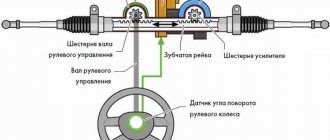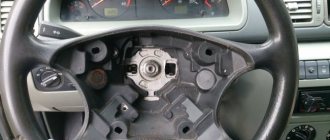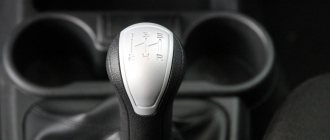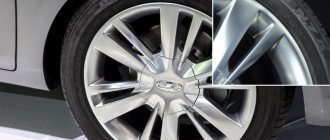How to understand that something is wrong
Any motorist is faced with the problem of noise when turning the steering wheel. In this case, noise may occur when the car is running. It doesn’t matter what the speed is, be it 40 km/h or 120 km/h. The car can stand still, take a turn, or the driver simply turns the steering wheel while standing still.
Despite the presence of power steering, it should operate silently. A slight hum or hiss in extreme positions is allowed.
Crunching, squeaking and knocking are signs of mechanical damage.
Causes of extraneous sounds
Causes of extraneous sounds when turning the steering wheel
There are many reasons that can cause noise, among them the most common are:
- Steering rack malfunction . Its wear or loosening.
- Steering column and problems associated with it.
- Malfunctions of suspension elements . These could be shock strut support bearings that require replacement, or ball joints.
- There is a problem with anthers . After they rupture, water and dirt enter the drive mechanism and cause it to malfunction. Therefore, a torn boot should be replaced immediately.
Why does the steering wheel squeak when turning: finding and eliminating the cause of the problem
It is extremely important to maintain the steering in good condition, since traffic safety directly depends on it. One of the problems that the driver runs the risk of encountering is the appearance of squeaking when turning the steering wheel. This symptom can occur both on cars with hydraulic power steering and on cars without power steering. The creaking can come either from the steering wheel itself or from under the front of the car. In this article, we will look at the main reasons why the steering wheel squeaks when turning and what to do in such a situation.
Contents: 1. How to determine the cause of a squeak when turning the steering wheel 2. Common causes of squeaking when turning the steering wheel - Wheel alignment is performed incorrectly - Silent blocks creak - Bearings creak - Steering rack or steering column creak - Tie rod ends creak - Plastic casing creaks
How to determine the cause of a squeak when turning the steering wheel
The steering mechanism of a car is quite complex, especially if it works in conjunction with a power steering. Because of this, there can be a lot of reasons that lead to squeaking when turning the steering wheel.
Carrying out diagnostic work that will allow you to determine the causes of the squeak should begin with identifying the specific place from which the squeak is heard when turning the steering wheel. To do this, you need to put the car in a hole and ask someone to turn the steering wheel, while listening to sounds from under the car to determine the location of the squeak. Having decided which element is creaking, you can move on to repairs.
Common causes of squeaking noise when turning the steering wheel
Here are the most common reasons why you hear a squeak when turning the steering wheel.
Wheel alignment performed incorrectly
If you hear squeaking noises from your tires, and it mostly happens when the car is stationary, there is a good chance that the problem is due to improper wheel alignment. In this case, it is necessary to perform a wheel alignment as quickly as possible to correct the problem.
Incorrect wheel alignment angles negatively affect the tires, which begin to wear unevenly and fail much faster than they should.
Silent blocks creak
A common problem that is often encountered in hot weather. If silent blocks begin to creak at high ambient temperatures, this is the first “bell” that they will soon fail.
The creaking of silent blocks in hot weather is due to their drying out. Since the main working material of silent blocks is rubber, at high temperatures it “dries out” and decreases in size, especially if we are talking about relatively old parts.
There is no danger in the creaking of silent blocks until the part breaks. Remove the silent blocks and carefully inspect them for cracks and various types of damage. If there are no visible problems, you can put them in place and continue driving, hoping that soon the air temperature will drop lower and the squeak will disappear.
Please note: For many modern cars you can find silent blocks made of polyurethane, which is not subject to the problem of “drying out” in the heat.
Bearings squeak
If you hear a squeaking, squeaking, or crackling sound from the steering knuckle when you turn the steering wheel, this most likely indicates a bearing problem. They behave in a similar way if there is not enough lubrication for their proper operation or if there is sand (or other foreign element) in the bearing.
Bearing creaking must be eliminated as quickly as possible so that the part does not fail completely. To do this, remove the bearing and inspect it for damage. If they are not found, then lubricate the part, install it in place and adjust.
Please note: When the squeaking of a bearing is caused by foreign elements entering it, be sure to find the reason for their entry into the part.
Steering rack or steering column creaks
It is quite simple to determine the creaking of the steering column by the characteristic vibration, which will also occur when the steering wheel rotates. Most often, the steering column clutch squeaks, and this problem is typical for cars that were unsuccessfully restored after a serious accident. This problem, if the noise is not strong, does not affect the quality of the steering mechanism, so you can continue to operate the car. The situation can only be corrected by replacing the steering column.
Also, a squeak can be heard from the steering rack and column joint if they are poorly adjusted or there is severe wear. Depending on the car model, this problem can be solved in different ways. Most often it is possible to adjust the mechanism.
Tie rod ends squeak
Due to damage to the anthers, foreign elements get into the tie rod end pin, which leads to squeaks both when turning the steering wheel and when overcoming obstacles. To determine if there is a problem, you need to inspect the tips, and if sand or other foreign matter actually got into them, you will need to replace them, and it is recommended to change them in pairs.
The plastic casing creaks
Every driver knows that when actively using a car that is not of the best build, “crickets” will appear over time. They represent creaks of the front panel, including the steering casing, made of plastic. This problem is solved in various ways, depending on the car model.
If all the parts described above have been inspected and the cause of the squeak cannot be determined, it is also recommended to check the power steering drive belt and brake elements, especially the pads and discs.
(419 votes, average: 4.54 out of 5)
okeydrive.ru
Diagnosis of knocking and grinding noises when turning the steering wheel
Before visiting a car mechanic, you should ask yourself and find answers to the following questions:
- what kind of noise is heard: creaking, grinding, whistling or knocking, or any other sound;
- Under what circumstances is the noise heard? When turning, entering a turn, standing still, or under other circumstances?
- Is the presence of noise a constant phenomenon, or is it triggered by a specific action or phenomenon? Whether it’s the weather (rain, heat), or the car being overloaded;
- does the noise depend on the direction of rotation;
- Are there additional issues that need to be addressed?
The answers to these questions will help an experienced technician quickly and efficiently determine the cause of the noise.
Knocking sound when turning the steering wheel
If the driver begins to notice a knocking sound when turning the steering wheel in place, this may be a sign of play in any unit. Most often this is due to natural wear and tear.
An inexperienced driver can confuse a knocking sound with just extraneous noise; sometimes these phenomena are combined.
Noise may occur when parts rub.
If, by placing your hand on the bipod of the steering gear and swinging it in different directions, you feel play or hear a knock, you can fix the problem using the adjusting screw. This is a faulty steering linkage.
If, when you get closer to the tip of the steering joint, you wobble it and hear a knocking sound, you should replace the ball joint with a new one.
A knocking noise may occur when turning the steering wheel while driving. These could be completely different problems.
What noises are possible when turning a wheel?
To correctly diagnose squeaks when turning the steering wheel, it is important to know the types of noise and potential causes of malfunctions:
- Hum. Consider the following situation. The car has been parked on the street for a long time, you start to steer and hear the sound mentioned above. Most often, the cause is a malfunction of the power steering wheel, and its solution is to add working fluid to the device’s reservoir. To diagnose the problem, look under the hood and check the current fluid level. If it drops below the minimum mark, then the reason for the hum is precisely the lack of lubricant. Please note that after adding fluid, it is important to determine the cause of the leak. This could be damage to the pipelines or a leak in any of the components.
In addition, a hum may occur if air gets into the power steering system, the belt loosens, or the pump fails. In the last three cases, only a visit to a service station will help. By the way, the mentioned problems can be diagnosed not only by the appearance of a hum. With such breakdowns, it becomes more difficult to steer, and additional rotational rigidity appears.
- Knock. When entering a turn, strange knocking noises appear, which often intensify as the steering wheel angle increases. In this case, one of the reasons is shock absorbers that do not perform their tasks. The solution is to replace faulty components. Due to uneven wear, a knocking sound when turning the steering wheel appears on one side.
Causes of knocking and solutions
Diagnosis of problems with the steering wheel
- A failed ball joint. In this case, it may simply burst. This entails the wheels turning inward or outward in an unnatural way. The car is unable to move on its own. The only way out is to replace the hinge with a new one.
- A failed grenade. If a knock is heard when turning the steering wheel to the right, then the left grenade is loaded. Naturally, to solve a problem such as a knocking noise when turning the steering wheel to the left, you should replace the right grenade and vice versa.
- Wear of stabilizer bushings. To solve the problem, you need to purchase silicone grease and simply spray it on the bushings.
- Steering rack malfunction or weakening. Diagnostics will help identify the problem and repair/replace the spare part.
- Loosening the engine crankcase protection bolts . To do this, you need to tighten the bolt, or replace it if the thread is broken. It is rare that a tap needs to be used to create a new thread.
- It is possible that after replacing the wheel the nut was not tightened properly , then a knocking noise may appear after an unsuccessful replacement, and over time it increases with vibration. The solution is to tighten the nuts to the desired torque.
- Considering the quality of spare parts and the conscience of sellers, a spring can easily burst . The solution to the problem lies in replacing it with a new spring.
- Leaking shock absorbers are another reason for the appearance of a characteristic knocking sound when the car squats. Replacing with a new shock absorber will help solve this problem.
Common causes of occurrence, noise elimination techniques
The driver of any vehicle should perceive extraneous creaking or grinding noises in the car’s mechanisms as an alarming signal. After all, we are often talking about mechanical wear of an element or its failure, which threatens loss of steering control.
A grinding noise when turning the steering wheel in place and in motion can be caused by a number of problems in the following components:
- errors when performing the wheel alignment procedure;
- steering rack;
- steering column;
- power steering;
- CV joints;
- ball joints;
- silent blocks;
- plastic elements of the interior and body.
Depending on where the sound appears, you need to analyze the problem and fix it.
In most cases of malfunctions, you will have to contact specialists, since troubleshooting the problem yourself will be difficult due to the complexity of the vehicle design and the risk of errors.
Incorrect vehicle alignment
If the source of squeaking when turning and while parking when twisting the steering wheel is the tires, then there is a high probability that the problem lies not in the steering itself, but in incorrect alignment.
Incorrect installation of the front pair of wheels will immediately affect the service life of the rubber: uneven wear will quickly cause it to fail. Therefore, when diagnosing wheel alignment errors, it is recommended to immediately contact a tire shop and repeat this procedure. It is better to use electronic equipment, since in this case errors in setting the correct position of a pair of wheels will be minimized.
Problems with the steering rack and steering column
One of the most common causes of a grinding noise when turning the steering wheel left or right is a malfunction of the steering rack. The creaking of the rack or column is accompanied by strong vibration on the steering wheel. If the noise and vibration are not strong, then further operation of the vehicle is permitted. However, as you drive, the symptoms of wear on the control elements intensify, which makes replacing the mechanism a necessary procedure.
The steering rack on cars produced in the last decade is a very complex mechanism. The car owner can only inspect the boots and determine their condition, but it is advisable to entrust a more in-depth analysis of the problem and repair work to professionals. The slightest mistake when repairing or replacing this mechanism can result in loss of control at high speed, so it is highly not recommended to fix the malfunction yourself.
Tie rod ends creaking
The steering linkage may also creak due to deformation of the anthers. If the boot is torn, sand can get into the tip through it, which causes squeaks. When inspecting the unit, it will be necessary to identify breaks.
The fault can only be eliminated by replacing a pair of tie rod ends with all components. The replacement can be done on your own if the car owner has the skills to independently maintain his vehicle.
In rare cases, the tie rod end may make unusual sounds due to friction with adjacent mechanisms. It will be necessary to adjust the position of the tips and replace the anthers. If one tip in a pair shows signs of wear, then the entire pair is replaced.
Ball and CV joint grinding
After several years of use, the ball joint wears out and begins to grind when moving. It is important to notice this sound in a timely manner and replace the support, since there is a danger of its failure when moving at high speed. It is also recommended to periodically check the condition of the boots, the tightness of which largely determines the service life of the ball joint.
If the driver hears crunching and grinding noises when turning the steering wheel left and right, then there is a high probability that the CV joint is failing. The bearing needs to be lubricated and the boot needs to be replaced. If the CV joint has mechanical defects, it must be completely replaced: such a part cannot be repaired.
Silent blocks creaking
Creaking when turning the steering wheel in place and while driving can be caused by wear of the silent blocks. As a rule, the rubber components of silent blocks begin to dry out gradually, which is especially noticeable in hot weather.
The uncharacteristic noise of silent blocks will be produced until the part breaks. It is important that creaking occurs only at high ambient temperatures and can disappear when it gets colder. If the silent block has no breaks and is not completely dry, it can continue to be used in the design of the machine. However, the first squeaks in the heat can already be considered a signal to replace these parts in the near future.
New generation cars are equipped with silent blocks made of high-strength polyurethane, which virtually eliminates the risk of them drying out in hot weather.
Bearings creaking
Unusual driving sounds coming from the steering knuckle when the steering wheel is rotated may indicate a problem with the bearings. Creaking and crackling noises accompany the operation of bearings when their lubricant runs out or sand gets inside the housing.
If the problem is not corrected in time, serious damage may occur. You will need to remove the bearings from the car and inspect them for damage. If no visible defects are observed, it is necessary to lubricate the part and install it in place. In case of damage, it is recommended to replace the bearing with a similar one.
Extraneous noise - crunching: causes and methods of solving the problem
The CV joint can cause a crunching noise when turning the steering wheel.
Crunching is usually a consequence of small noises (clicks and clatters). It may be the result of a serious breakdown, or it may be a minor malfunction.
The CV joint is in constant motion and bears heavy loads, which minimizes the time it is used.
It happens that you hear a crunching sound when you turn the steering wheel while driving. At the same time, it seems that the car literally crunches. You often hear noise when turning in a certain direction.
Owners of front-wheel drive and all-wheel drive cars face this problem. The noise is associated with a broken grenade (CV joint).
You can check the crunch when turning the steering wheel in place.
Steering wheel creaks in place
Interestingly, squeaking when turning the steering wheel in place, just like with the steering rack, can occur due to damaged steering rod boots. It is the debris and dirt in the protection that can contribute to squeaking when turning the steering wheel. This sound can be heard both while driving and while parked. All you need to do is clean the components from dust and dirt with the familiar WD-40 product, and replace the worn boots with a new and high-quality product. But it’s better not to start everything up, and not to wait until the steering wheel squeaks again, but to periodically check the condition of the boots and, if necessary, replace them.
Important! If the steering wheel not only makes a grinding noise when turning, but also wobbles a little and vibrates, the problem is not only in the steering rod, but also in the steering joint. Such a hinge may wear out over time and require replacement. If you do not replace the part in time, the hinge itself may jam, and you need to be reminded what will happen if the steering wheel starts to jam while driving and turns poorly.
Another reason for squeaking when making turns is an insufficient amount of fluid in the power steering. Typically, such a squeak will only be heard when the steering wheel is turned while the car is stopped. The first thing to do is try to replenish the fluid in the power steering reservoir. If this method does not help, you need to carry out a full diagnosis and, if necessary, repair the pump and other power steering elements. These elements are quite complex to repair at home, so it is better to contact a service station.
Incorrect wheel alignment can also cause a crunching sound every time you turn the steering wheel. Diagnostics and debugging are carried out only in car services, using computer diagnostics. The service will set the exact angle of the wheels, which will not only get rid of squeaking, but also help avoid severe wear of the tire rubber.
Also, a crunching or rubbery squeak when turning the steering wheel may indicate that the ball joints are worn out. If such problems are detected, urgent diagnostics must be carried out. In the event of a breakdown, it is necessary to replace the broken part with a new support. If you can't find a new ball joint, you can use lubricant. This repair will be temporary and will need to be replaced in the future. If you do not replace the ball joint in time, there is a possibility that the wheel will come off at high speed. In this type of accident, it is rare for anyone to escape without injury.
Having learned about a malfunction in the steering part, there is no need to hesitate. It is important to remember under what circumstances the noise occurs and contact a car service center. With correct diagnostics and skillful hands, the car will be on the road again. The steering part is one of the most important parts of the car, so you should not carry out repair work yourself. Finding a quality car service is not easy, but the Uremont.com website makes the search much easier. You just need to submit a request for car diagnostics and select a suitable car service from the list. Thus, you can quickly and easily repair your car thanks to our service.
Why is grinding heard and how to deal with it
If you hear a grinding noise when you turn the steering wheel, this indicates wear on the steering system joints or front suspension. To find out the exact cause, it is worth carrying out diagnostics at a service station and replacing the failed spare part.
Noise can occur when turning the steering wheel: a grinding sound when driving, or when the car is stationary. The cause of this noise lies in the failure of the support bearings of the strut or lower ball joint.
If you hear a grinding noise in the wheel when you turn the steering wheel, there can be many reasons. Experienced drivers advise contacting a car mechanic, driving the car into an inspection pit and having a look. Among the reasons are:
- The rubber on the cardan outboard bearing is torn. Stones and rubble can get into it;
- The grinding noise may occur when the pads rub against the discs;
- Another reason could be a loose locking ring.
In sub-zero weather, when turning the steering wheel all the way, a grinding noise is heard due to lack of lubrication. In this case, additional application of lubricant will help.
Creaking noise when turning the steering wheel
Diagnosis of squeaking noise when turning the steering wheel
When operating the steering wheel, you can often hear a squeak when turning the steering wheel in place. There can be many reasons for this.
- The outer hinges are worn. If so, they just need to be replaced.
- The front wheel bearings are worn out. It is also possible that the hub nut may become loose. To solve the problem, you need to tighten the nuts or, if necessary, replace the bearings.
- A spring creaking when turning the steering wheel to the right, or a creaking sound when turning the steering wheel to the left may be caused by its breakdown. Replacing the spring with a pair will solve the problem.
- Loosening the bolts securing the wheel, the stabilizer bar to the body, the front suspension steering knuckle to the strut, the nuts of the silent blocks of the suspension arms.
For your peace of mind, it is better to show the car to an experienced car mechanic. He will drive the car into the inspection hole and will be able to accurately identify the breakdown or malfunction and quickly fix it.
Results
Remember that undercarriage repairs should not be put off for a long time, because this is a fundamental factor for safe driving.
Contents: A grinding, knocking, hum or squeaking sound when turning the Renault Logan steering wheel forces the car owner to pay attention to the problem and urgently take measures to correct the breakdown. Such actions are justified, because ignoring strange noises leads not only to the weakening of the nervous system, but also to the appearance of more serious malfunctions in the future. The result can be sad - from the failure of more expensive components to the loss of controllability on the road. What noises are possible when turning the steering wheel? How to diagnose them? What to do if a squeak appears? We will consider these and other questions below.
Whistle or hum when turning the steering wheel
A hum or whistle when turning the steering wheel is typical for cars with various types of power steering. Rarely does a whistle occur when the steering wheel is turned to one side.
If you hear a whistle when turning the steering wheel all the way, it may be worth tightening the belt with a roller. Or a pump malfunction. Experienced technicians advise not to leave the car with the wheels turned out, as the power steering fluid may boil, which will lead to pump failure.
If you hear extraneous noises when turning the steering wheel, you should pay attention to them.
Also, turning the steering wheel to extreme positions increases the load, causing extraneous noise. In order for the car to last longer, and the driver and passengers to feel safe, it is worth having the car diagnosed at least once every six months.
Logan steering wheel creaking when turning: reasons and recommendations for action
If you start to steer, but at the same time you hear an unpleasant grinding noise, this is a reason to pay attention to the condition of the Renault front suspension. First, decide what you are dealing with. As mentioned, extraneous sounds can be of various types. Most often it is noise and things. In the first case, the acoustic effect appears in the event of friction between different surfaces, and in the second - when a backlash is formed (occurs in the event of wear of a particular part). The worst thing is when these noises merge with each other, and then diagnosing the problem is even more difficult.
If you hear extraneous squeaks when entering a turn, proceed as follows:
- Decide on the side where the extraneous noise comes from (this has already been mentioned above). Diagnostics is not difficult - the sound will appear when the steering wheel is turned to one side.
- When the problem area is identified, turn the wheels and inspect the condition of the rubber boots on the grenades. If there are ruptures, then there is most likely already dirt or other foreign debris inside. Once mixed with lubricant, the composition becomes even more dangerous and quickly leads to wear of the mechanism.
If a grenade breaks down, diagnosing the problem is easy. When making a turn, you hear an unusual crackling noise that goes away when the steering wheel stops rotating or when the steering angle is adjusted.
Please note that when diagnosing a problem and troubleshooting a malfunction, you must know the design features of the suspension and the intricacies of its repair.
Below we will consider the main causes of creaking and the first actions when a problem occurs:
- The reason is a ball or vibration support, support bearing. When the first noise appears when turning the steering shaft, pay attention to each of the mentioned parts. The presence of deformation, damage or increased play is a reason to replace the device. If necessary, change the following components:
- Ball joint.
- Support type bearing.
- The stabilizer bushing or the strut itself.
Vibration support.
Please note that it is not a specific node that may be faulty, but a group of elements. For example, the rubber bushing is damaged and play appears in the ball joint. The repair in this case must be comprehensive. At the same time, it is advisable to check the entire Renault steering system to prevent the occurrence of more serious malfunctions in the future.
Please note that to carry out a complete diagnosis you will need an overpass or a garage with an equipped pit. Also keep in mind that it will be difficult to do all the work yourself - use the help of a partner. If you do not have the necessary skills, contact your dealer or service station, where specialists will quickly determine the cause and eliminate it.
If there is a problem, proceed as follows:
- Hang one side of the car on a jack, which raises one of the cups.
In this case, a gap appears into which you drive new grease. The best option is to use a silicone-based composition. In this case, the lubricant should be thick.
Pay attention to the condition of the rubber boot installed on the tip. It must be intact, without damage or deformation. If there are cracks or lubricant leaks, the CV joint rubber element will need to be replaced.
If an extraneous sound is heard when the steering wheel rotates in the rack, tightening the rack itself may help.
Self-identification of causes
VAZ 2110 knocking when turning
If you go to a service station or VAZ car service center, you should not expect that the cause will be discovered. For this reason it is recommended:
- First, rinse the entire front suspension with running water:
- wait until it dries or at least flows around;
- drive into a garage with an inspection hole;
- clean with a brush all places of twists and connections;
- thoroughly visually inspect the entire front suspension.
Note. This needs to be done because there can be many reasons.
VAZ 2110 creaks when turning the steering wheel
Design features of the front suspension system
VAZ 2110 crunching when turning
This system is the most important part of a front-wheel drive vehicle. It consists of telescopic hydraulic shock absorber struts, coil springs, lower wishbones with braces, and a stabilizer bar. The structural part is a shock absorber strut. Its bottom is connected to the steering knuckle with 2 bolts. The strut bracket has a hole at the top through which it is bolted to the body. The bolt has an eccentric collar and an eccentric washer. This bolt is used to adjust the wheel alignment of the drive hubs. The following structural parts are mounted on the telescopic stand:
- spring;
- polyurethane foam compression stroke buffer;
- upper strut support assembly with bearing.
VAZ 2110 creaking when turning the steering wheel
- The upper support is attached with 3 nuts, which have design features, to the body pillar. The support has good elasticity, due to this it swings while driving, which dampens body vibrations. The support bearing of the strut makes it possible to make turns together with the wheels.
- A telescopic hydraulic shock absorber is mounted inside the strut. If the shock absorber breaks down, it can be replaced with a cartridge.
- The ball joint connects the lower part of the steering knuckle to the lower control arm. It is secured with 2 blind bolts, since the hole in the steering knuckle is not through.
Note: you need to carefully start unscrewing these bolts, first you need to carefully tap them and clean them with a metal brush.
- The longitudinal braces of the front suspension system are connected by silent blocks to the lower arm and beam. They regulate the braking and traction forces of the machine during movement. There are washers on both sides of the extension where the connection occurs; they serve to adjust the angles of the partial slope of the turning axis.
A 2-row angular contact bearing is secured in the steering knuckle with 2 lock washers. There is a bearing installed on the wheel hub; it is tightened with a nut; there is no need to adjust its tightening.
Note. After carrying out repairs to eliminate the knocking of the suspension system, it is necessary to visit a car service center, as it is necessary to balance the tires and check the wheel alignment. Without balancing the tires, noise may occur when driving.
VAZ 2110 knocking when turning the steering wheel
If the wheels are misaligned, the vehicle's stability is lost and it is difficult to maintain direction. One-sided tire wear also occurs, which will then affect the further operation of the car. You need to think before you take the car to a car service center, check the fastenings yourself from the pit, and identify the cause of the knocking.
Front strut supports for VAZ 2110
After studying the literature on the design features of the machine, you can safely proceed to action. Since such repairs will not require extra financial costs and will not take much time. Because it will be necessary to tighten the loose threaded parts, and also replace several failed rubber parts. Therefore, you just need to carefully watch the video clips and study the photos, which show in detail the design feature of the front end. They clearly indicate the order of work; the description describes the structural arrangement of the main design features of the suspension system. The above instructions will help you do everything correctly, as a result of which the cost of repairs will be purely symbolic, because you will only have to pay for certain parts that will need to be replaced.











